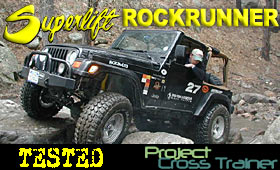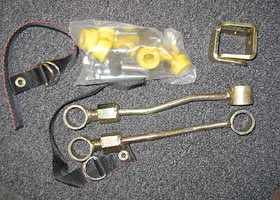
Superlift's
sway bar disconnects are easy to use. |
Opening A
Can of Worms
Anytime
you make a modification to your Jeep you open a can of worms. The
biggest can that you will ever open is probably installing a suspension
lift (unless you are trying to stuff a rocket motor in your Jeep).
Opening the can is not always a bad thing, though. It will usually
lead you to do other modifications that you will enjoy and probably
needed, anyway. Every time you modify some part of your Jeep some
other part may be affected, even if you do not recognize that anything
has changed. The following are some of the things to think about
when lifting a Jeep and the worms associated with them:
Center of
Gravity
Ok,
call me master of the obvious here, but any time you raise the height
of the vehicle you change the center of gravity. This is the balance
point of the vehicle if it were suspended in the air. It is also
the point that all the dynamic forces act upon (acceleration, deceleration,
turning, etc.). The higher this point is from the ground, the less
stable a vehicle typically is. The solution to this is to run a
wider tire with appropriate offset rim. While this will help to
stabilize the new higher center of gravity, the driver should also
be aware of these new dynamics. This, of course, goes for any suspension
kit, not just he Superlift.
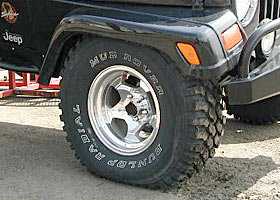
Dunlop 33"
Radial Mud Rovers on Ultra 50 rims. |
Rubber Room
Since
we were just speaking of tires and wheels, let us follow through
with that thought. The whole purpose of a lift is to make room for
bigger tires to increase overall ground clearance, approach and
departure angles, etc. Since the "Cross Trainer" needs
to be a great off and on-road rig, we made the decision to go with
"little big" rubber.
The 33x12.50R15
Dunlop Mud Rovers will give us the clearance and grip to do 80%
of the trails while still offering the on-road manners we need for
the daily trip to the office. To get them to fit correctly, we needed
the correct backspacing on the wheels. Remember, the lift will give
you the vertical clearance for the larger tires, but you need to
have the right wheel backspacing to make the larger tire fit while
turning the wheels. We chose to put a beautiful set of Ultra Type
50 polished aluminum wheels on to accomplish this. Our other option
would have been to use a wheel spacer on the factory wheels like
the ones from JKS Manufacturing. You can look for more detailed
information on all of these items in future articles.
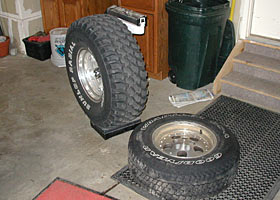
Tire size
and weight changes your overall drive ratio. Keep this in mind
and pick the right gears. |
Gear Head
The
right gears are worth their weight in gold! Gears and gear ratios
seem to be one of the most misunderstood aspects among four wheelers.
I am not going to get into massive detail on this one now, however.
I will give you something to think about, though. We will use the
Cross Trainer as our example.
Our Jeep came
with a 4.0L motor, 5 speed transmission, 3.73 axle gears and 30
inch tires from the factory. By putting on larger tires, we changed
a couple of very important things when it comes to power and gas
mileage. This first thing is very obvious. Since the tires are bigger,
they change the overall drive ratio of the Jeep. The larger wheel
travels a further distance for every revolution. This causes the
engine to run at a lower RPM.
You might think
that this is good at first. But it can be very wrong. Lets say the
engine is designed to produce its most efficient power and mileage
at 2500 RPM at highway speed. With the larger tires in place it
may only turn 2200RPM at the same speed. This causes the engine
to "lug" and work harder, which means that it is now eating
up more of that expensive gas. Not to mention that you're off-road
crawl ratio is now worse than it was before.
Here is the
second part that is not often considered in the off-road world.
There is a distinct difference between the "Sprung" and
"Un-sprung" mass of a vehicle. The sprung mass is simply
everything held up by the suspension. While un-sprung mass is everything
below. The vehicles' ability to move and control un-sprung mass
is more difficult than it is to control sprung mass. (That is why
the large part of the vehicle is above the springs.) The amount
of effect depends on the particular vehicle.
A good general
rule seems to be that each pound of un-sprung mass = 10 lbs of sprung
mass. How does this affect our Jeep? Each one of my stock tires
weighed 51 Lbs. Each one of the new tires weighs 68 Lbs. This means
that my Jeep has to move, stop and turn with the effect of 680 more
lbs. of weight on-board. If you check a gear ratio chart you can
see what gears you need to change to in order to regain your power
and gas mileage.
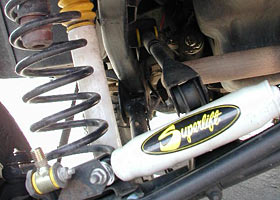
Superlift's
Rockrunner kit is very complete and includes a new steering
stabilizer. |
Brake Point
You
can probably see some of the obvious concerns with the brakes now.
The increase in un-sprung mass will make stopping distances greater.
Upgrading to better brake pads, stainless steel brake lines, etc
will help in this area. If your Jeep has an Anti-lock Braking System
on it you will need to make sure you have the right speedometer
gear in the transfer case for the ABS to work like it did from the
factory. The computer that controls the ABS measures wheel speed
(larger tires=slower rotation per distance traveled) and compares
this to the speed it thinks the vehicle is going to determine when
to use and not use the ABS.
Vibe Time
Lifting
a Jeep can cause all kinds of different sensations to flow into
the driver's seat. Vibrations from a drive line that is too steep
are one of the most common. The Superlift system came with cam bolts
and a transfer case lowering kit to help correct the driveline vibrations.
While this works fine in most cases, it does cause a loss in ground
clearance and a shorter shifter in the cab of the Jeep. The loss
of ground clearance is our main concern since we lifted the Jeep
to gain ground clearance. A slip yoke eliminator kit with a longer
drive shaft would be a much better option. These kits leave the
transfer case in the factory position and eliminate the vibrations.
JB Conversion and Tom Woods are great sources for these. Look for
more detailed information on both soon!
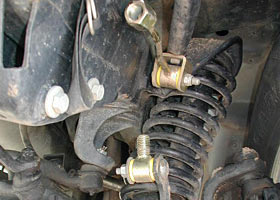
The springs
squash nicely when fully compressed. |
Little Stuff!
There
are a few little things to remember after you install the lift too.
· Adjust
the headlights downward a touch
· Adjust the parking brake cable
· Adjust the mirrors
· Don't "Armor All" the passenger side step. (Trust
me on this one, your buddy has a lot farther to fall now.)
· Remember to watch where you are driving and not at your
reflection in store windows. It's just a lift! You're not that cool
yet! Keep reading in months to come and it will get much cooler.
|
